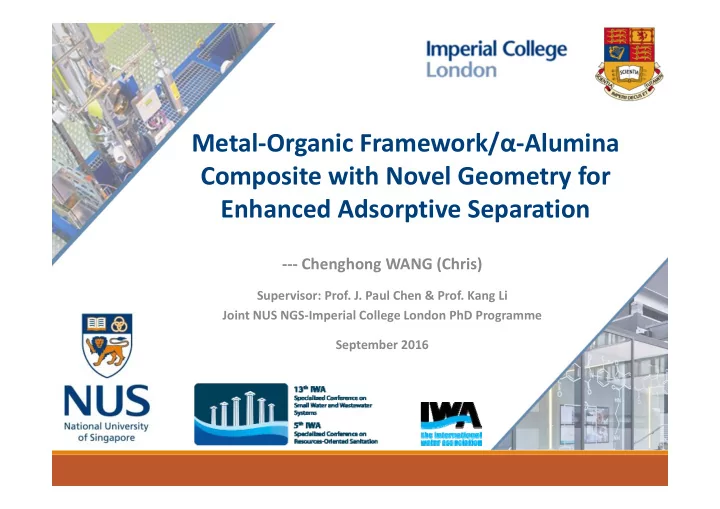

Metal ‐ Organic Framework/ α‐ Alumina Composite with Novel Geometry for Enhanced Adsorptive Separation ‐‐‐ Chenghong WANG (Chris) Supervisor: Prof. J. Paul Chen & Prof. Kang Li Joint NUS NGS ‐ Imperial College London PhD Programme September 2016
1
Overview • Introduction on MOF/alumina composite • Adsorptive separation study – Arsenic contaminated water remediation • Discussion & Future work “Wang, C. et al., Chem. Commun. , 2016, 52 , 8869 ‐ 8872” 2 Introduction (materials) Performance Study Discussion
Adsorptive Separation • Industrial process for the purification of liquid or gas mixtures. • Fixed & fluidized beds • Drawbacks including: – 1) large pressure drop – 2) channelling of fluid – 3) break ‐ up of adsorbent pellets • Novel concept and design! 3 Introduction (materials) Performance Study Discussion
Metal Organic Framework (MOF) • Definition: – “Inorganic metal ions or metal containing clusters” +“organic ligands” • Unique features of this porous material: – large surface area & great porosity – customizable chemical functionalities Zr ‐ MOF UiO ‐ 66 : – relatively mild synthesis conditions Zirconium oxide unit + BDC linker • Applications: – adsorption, separation, sensing, catalysis, etc. 4 Introduction (materials) Performance Study Discussion
UiO ‐ 66 Adsorbent • Hydro ‐ stable, even under acidic or some alkaline conditions • UiO ‐ 66 for aquatic arsenic adsorption ( Scientific Reports, 16613, 2015 ) – Wide pH working range (1 ‐ 10) – Great thermodynamic capacity (303 mg/g) – Fast kinetic behaviour • To be industrially applied => Binder problem? 5 Introduction (materials) Performance Study Discussion
α‐ Alumina • Abundant supply in raw material & great resistance to various conditions • Hollow fibre structure with novel geometry as advanced matrix – micro ‐ channels serving as reaction chamber – thin barrier layer serving as sieve 6 Introduction (materials) Performance Study Discussion
MOF/ α‐ Alumina Composite Vacuum filtration method Size ‐ exclusion effect 7 Introduction (materials) Performance Study Discussion
MOF/ α‐ alumina Composite for Arsenic Contaminated Water Remediation Arsenic pollutant removal from water • Arsenic contamination is a global threat due to its toxicity and carcinogenicity • Arsenic concentration in most contaminated water ranges from 0.1 – 1 ppm. • 1 ppm as the feed concentration 8 Introduction (materials) Performance Study Discussion
MOF/ α‐ alumina Composite for Arsenic Contaminated Water Remediation 9 Introduction (materials) Performance Study Discussion
Comparison Study by Packed Column Beds Inferior performance • Random packing & non ‐ ideal flow • Even worse when limited amount of adsorbent were used 10 Introduction (materials) Performance Study Discussion
MOF/ α‐ alumina Composite for Arsenic Contaminated Water Remediation Alternative concept for adsorptive separation • Micro ‐ channels – adsorbent distribution – transport network (reduced mass transfer resistance) – more ideal flow • Barrier layer – separation for suspended solids & micro ‐ organisms • Binder problem solved • Module assembled 11 Introduction (materials) Performance Study Discussion
MOF/ α‐ alumina Composite for Arsenic Contaminated Water Remediation Alternative concept for adsorptive separation • Micro ‐ channels – adsorbent distribution – transport network (reduced mass transfer resistance) – more ideal flow • Barrier layer – separation for suspended solids & micro ‐ organisms • Binder problem solved • Module assembled 12 Introduction (materials) Performance Study Discussion
Revisit Key Points • MOF/ α‐ alumina composite with novel geometry was developed for enhanced adsorptive separation • The composite is able to produce potable water recovery from arsenic contaminated water • To achieve a similar performance, the packed column bed required 8X amount of active UiO ‐ 66 adsorbents 13 Introduction (materials) Performance Study Discussion
Future Work • More functional composites can be formed, based on the application purpose and the functionality of adsorbents • Gas chromatography separation, • Catalytic reaction, • etc. 14 Introduction (materials) Performance Study Discussion
References & Acknowledgement • Pictures used are adopted from Google Images without financial purposes. • I. Ali, Chem Rev , 2012, 112 , 5073. • H. Furukawa, K. E. Cordova, M. O'Keeffe and O. M. Yaghi, Science , 2013, 341 , 1230444. • H. C. Zhou and S. Kitagawa, Chem Soc Rev , 2014, 43 , 5415. • N. A. Khan, Z. Hasan and S. H. Jhung, J Hazard Mater , 2013, 244 ‐ 245 , 444. • J. H. Cavka, S. Jakobsen, U. Olsbye, N. Guillou, C. Lamberti, S. Bordiga and K. P. Lillerud, J Am Chem Soc , 2008, 130 , 13850. • C. Wang, X. Liu, J. P. Chen and K. Li, Sci Rep , 2015, 5 , 16613. • J. He, T. S. Siah and J. Paul Chen, Water Res. , 2014, 56 , 88. • M. Lee, B. Wang and K. Li, J. Membr. Sci. , 2016, 503 , 48. • X. Liu, N. K. Demir, Z. Wu and K. Li, J Am Chem Soc , 2015, 137 , 6999. • J. He, T. Matsuura and J. P. Chen, J. Membr. Sci. , 2014, 452 , 433. • K. Li, Ceramic membranes for separation and reaction , Wiley, 2007. 15 Introduction (materials) Performance Study Discussion
Thanks for Listening !! 16
Recommend
More recommend